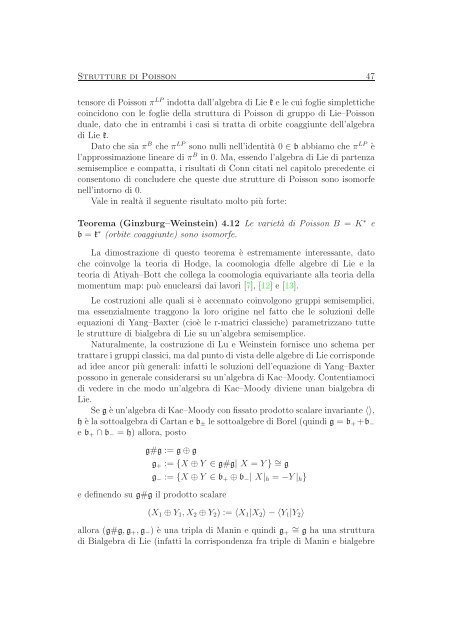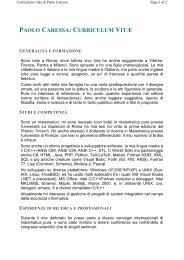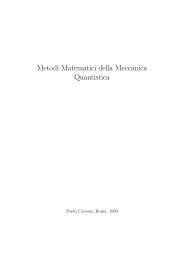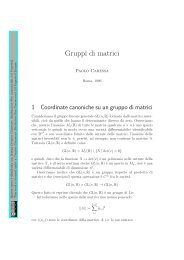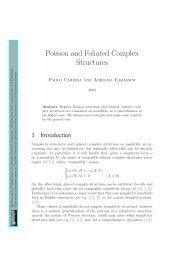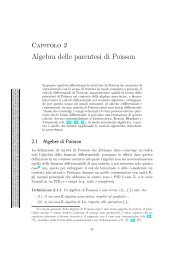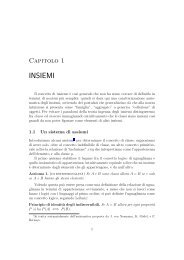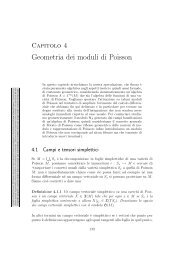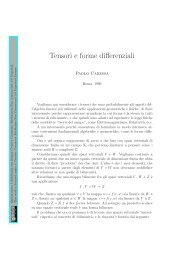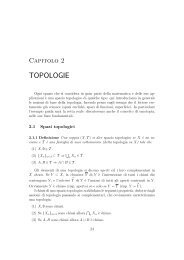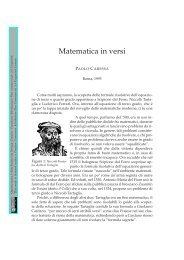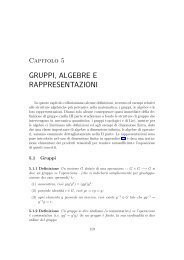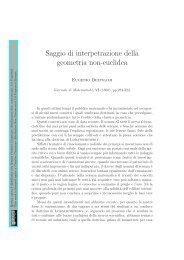You also want an ePaper? Increase the reach of your titles
YUMPU automatically turns print PDFs into web optimized ePapers that Google loves.
<strong>Strutture</strong> <strong>di</strong> <strong>Poisson</strong> 47tensore <strong>di</strong> <strong>Poisson</strong> π LP indotta dall’algebra <strong>di</strong> Lie k e le cui foglie simplettichecoincidono con le foglie della struttura <strong>di</strong> <strong>Poisson</strong> <strong>di</strong> gruppo <strong>di</strong> Lie–<strong>Poisson</strong>duale, dato che in entrambi i casi si tratta <strong>di</strong> orb<strong>it</strong>e coaggiunte dell’algebra<strong>di</strong> Lie k.Dato che sia π B che π LP sono nulli nell’ident<strong>it</strong>à 0 ∈ b abbiamo che π LP èl’approssimazione lineare <strong>di</strong> π B in 0. Ma, essendo l’algebra <strong>di</strong> Lie <strong>di</strong> partenzasemisemplice e compatta, i risultati <strong>di</strong> Conn c<strong>it</strong>ati nel cap<strong>it</strong>olo precedente ciconsentono <strong>di</strong> concludere che queste due strutture <strong>di</strong> <strong>Poisson</strong> sono isomorfenell’intorno <strong>di</strong> 0.Vale in realtà il seguente risultato molto più forte:Teorema (Ginzburg–Weinstein) 4.12 Le varietà <strong>di</strong> <strong>Poisson</strong> B = K ∗ eb = k ∗ (orb<strong>it</strong>e coaggiunte) sono isomorfe.La <strong>di</strong>mostrazione <strong>di</strong> questo teorema è estremamente interessante, datoche coinvolge la teoria <strong>di</strong> Hodge, la coomologia dfelle algebre <strong>di</strong> Lie e lateoria <strong>di</strong> Atiyah–Bott che collega la coomologia equivariante alla teoria dellamomentum map: può enuclearsi dai lavori [7], [12] e [13].Le costruzioni alle quali si è accennato coinvolgono gruppi semisemplici,ma essenzialmente traggono la loro origine nel fatto che le soluzioni delleequazioni <strong>di</strong> Yang–Baxter (cioè le r-matrici classiche) parametrizzano tuttele strutture <strong>di</strong> bialgebra <strong>di</strong> Lie su un’algebra semisemplice.Naturalmente, la costruzione <strong>di</strong> Lu e Weinstein fornisce uno schema pertrattareigruppiclassici, madalpunto<strong>di</strong> vistadellealgebre<strong>di</strong>Liecorrispondead idee ancor più generali: infatti le soluzioni dell’equazione <strong>di</strong> Yang–Baxterpossono in generale considerarsi su un’algebra <strong>di</strong> Kac–Moody. Contentiamoci<strong>di</strong> vedere in che modo un’algebra <strong>di</strong> Kac–Moody <strong>di</strong>viene unan bialgebra <strong>di</strong>Lie.Se g è un’algebra <strong>di</strong> Kac–Moody con fissato prodotto scalare invariante 〈〉,h è la sottoalgebra <strong>di</strong> Cartan e b ± le sottoalgebre <strong>di</strong> Borel (quin<strong>di</strong> g = b + +b −e b + ∩b − = h) allora, postog#g := g⊕gg + := {X ⊕Y ∈ g#g| X = Y} ∼ = gg − := {X ⊕Y ∈ b + ⊕b − | X| h = −Y| h }e definendo su g#g il prodotto scalare(X 1 ⊕Y 1 ,X 2 ⊕Y 2 ) := 〈X 1 |X 2 〉−〈Y 1 |Y 2 〉allora (g#g,g + ,g − ) è una tripla <strong>di</strong> Manin e quin<strong>di</strong> g +∼ = g ha una struttura<strong>di</strong> Bialgebra <strong>di</strong> Lie (infatti la corrispondenza fra triple <strong>di</strong> Manin e bialgebre


